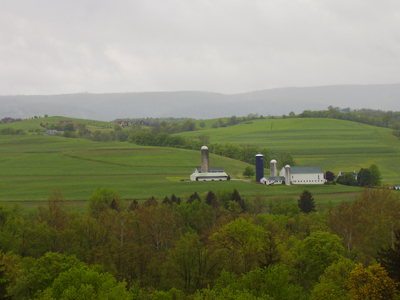The Laurel Highlands are a special place in Pennsylvania. Part of the Allegheny Mountains, the Laurel Highlands stretch from the Conemaugh River south into Maryland. The Laurel Highlands are known for their diversity of plant and animal life, forested mountain ridges, pristine streams, recreational opportunities and scenic beauty.
The significant variety of landscapes in the Laurel Highlands produces a high level of forest community diversity. Lower slopes and coves support rich, mixed forests dominated by tuliptree, red oak, eastern hemlock, sugar maple, American beech, pawpaw and basswood. Sandstone and limestone rock formations embedded within mature forests create micro-habitats relied upon by many plants and animals. Forests high on the plateau and mountain ridges encompass species, rich bogs and other non-riparian wetlands. Intact forests on mountain ridges are also important corridors for migratory birds.
Flowing through the forestlands of the Laurel Highlands are its streams and rivers. Many of the cool, shaded streams in the region are able to maintain their quality because of low levels of human disturbance. Many of these streams are popular recreational resources for anglers.
Along the banks of the Lower Youghiogheny River, including along the lower reaches of major tributaries such as Indian Creek, lies a unique complex of plant communities. Both river-bank and floodplain-dwelling plants exist among the bedrock outcrops, rock shelves, boulder fields, cobbles and gravel bars characteristic of high gradient streams and rivers. Depending on the effects of natural disturbance factors such as flooding and ice scour, these plant communities and species may include sycamore floodplain forests, sycamore scrub and patches of big bluestem and Indian grass. Since 1951, we’ve protected more than 83,000 acres of the Laurel Highlands’ rivers, forestlands, wild areas and scenic ridges.
Ligonier Valley

The Ligonier Valley is an important component of our Laurel Highlands priority conservation landscape. Since 1979, we’ve been working to conserve the unique features of this valley. Our Mountain Streams Project has added 9,600 acres of land to Forbes State Forest in the valley, while more than 10,000 acres of private land has been protected through conservation easements. This long history of conservation successes is the result of collaboration and a shared vision between the Conservancy and many landowners in the valley. By using a variety of conservation techniques, the program works with the local community to protect and enhance the unique natural character of the Ligonier Valley and the greater Laurel Highlands region.
Flanked by Chestnut and Laurel Ridges, the valley features two of the Conservancy’s priority watersheds, Tubmill Creek and upper Loyalhanna Creek. The forested ridges provide habitat for several species of special concern whose habitats are being threatened, including Allegheny woodrat and Indiana bat. The forests of the valley provide important corridors for wildlife movement and water quality protection. Our conservation efforts in the valley focus on protecting these ecologically significant features.
